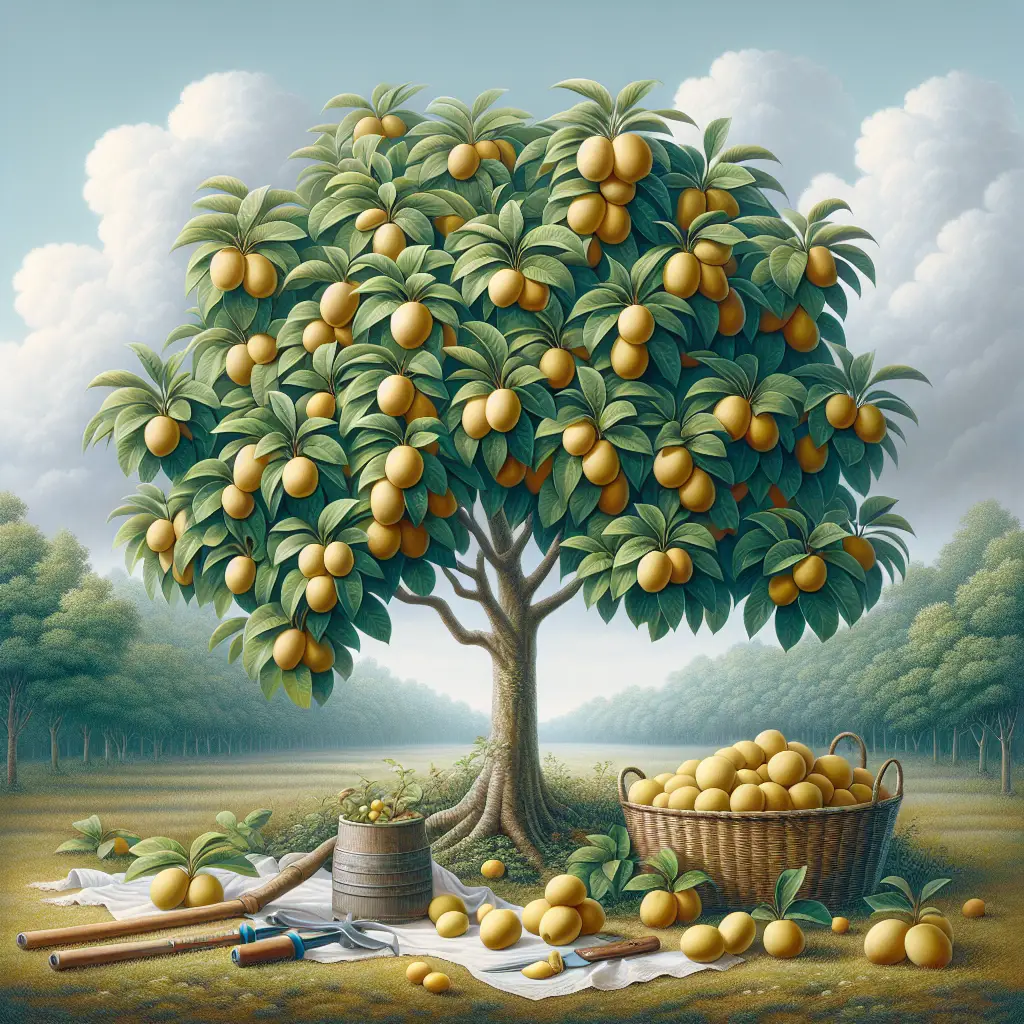Growing Surinam Cherries in Your Backyard
Published January 14, 2024 at 12:32 am

Introduction to Growing Surinam Cherries
- Pet Friendly: Generally safe, but consumption in large quantities can be harmful.
- Light Requirements: Thrives in full sun to partial shade.
- Watering: Regular watering, but allow soil to dry out between sessions.
- Humidity: Tolerates moderate humidity.
- Temperature: Prefers warm climates, not frost tolerant.
- Difficulty: Moderate, suitable for gardeners with some experience.
Understanding the Basics of Surinam Cherries
Before you, my fellow green thumbs, embark on the journey of cultivating Surinam cherries in your backyard, it’s essential to grasp what makes this fruit plant unique. The Surinam cherry, or Eugenia uniflora, is a tropical evergreen shrub hailed for its vibrant red and black cherries with a distinct, tangy flavor. Recognizing their glossy, deep green leaves and beautiful, clustered flowers can help you spot them easily.
Originating from South America, these shrubs can adorn your garden with their presence, provided they’re cared for appropriately. So, if you’re intrigued by adding an exotic flair to your green space, you’re in for a treat with this guide on growing and nurturing Surinam cherries.
Choosing the Right Spot for Surinam Cherries
Location is key when it comes to planting Surinam cherries. You’ll want to select a spot that receives a generous amount of sunlight. While they can manage partial shade, too little sun can impede their growth and fruit production. Acknowledge the space they need to flourish – these plants can spread out.
Moreover, Surinam cherries aren’t fond of the cold. They perform best in USDA hardiness zones 9 through 11. If you reside in a cooler climate, consider growing them in a container that can be moved indoors during frosty conditions.
Soil Requirements and Planting
The base for any plant’s success is the soil it’s rooted in. Surinam cherries require well-draining, fertile soil to prevent waterlogging, which can lead to root rot. Amending your garden soil with organic compost prior to planting will give them a significant boost.
When planting, dig a hole twice the width of the root ball and just as deep. This allows the roots to spread and anchor with ease. Incorporating a slow-release fertilizer can also encourage a robust start for your new cherry plant.
Watering and Feeding Your Surinam Cherries
Getting the watering balance right can be the difference between thriving cherries and a gardening mishap. During initial growth, keep the soil consistently moist without over-watering. As they mature, they’ll become more drought-tolerant, allowing for a more relaxed watering schedule.
Fertilizer is the secret sauce to a fruitful harvest. An organic, balanced fertilizer, applied during the growing season, can invigorate your Surinam cherry plants. High-quality brands, such as FoxFarm’s Fruit & Flower fertilizer, have received commendable reviews for boosting fruit plants’ productivity. Anecdotal evidence suggests that this product enhances the sweetness and size of the cherries, contributing to an abundant yield.
Find This and More on Amazon
Pruning and Maintenance
Surinam cherries aren’t high-maintenance, but they do appreciate a good prune. Pruning helps to shape the plant, encourage air circulation, and promote healthier fruit production. The best time to prune is after the harvest, as this can stimulate new growth, where next season’s cherries will blossom.
Mind the pests and diseases that might target your plants. Keep an eye out for aphids, scale, and fruit flies which are attracted to the sweet fruit. Neem oil, a renowned natural pesticide, can be a game-changer in managing these pests organically. When used correctly, as shared in countless garden forums, neem oil has been effective in keeping these nuisances at bay without harming the plant or the surrounding environment.
Find This and More on Amazon
Harvesting and Enjoying the Fruits
Patience pays off when it comes to enjoying the fruits of your labor. Surinam cherries will reach maturity and be ready for harvest typically in the spring. The cherries transition from green to vibrant red and finally to a deep, almost black hue when ripe.
Indulge in these little gems fresh off the bush or incorporate them into jams, jellies, or desserts for a tropical twist. Remember, while generally pet friendly, if you have furry friends around, ensure they don’t overindulge, as the seeds are not safe for consumption.
Pest and Disease Prevention
Healthy Surinam cherry plants can sometimes fall victim to pests and diseases just like any other garden plants. Implementing preventive measures is essential for maintaining robust plants. Regular inspections for signs of trouble, such as discolored leaves or damaged fruit, can help you spot and address issues early.
Some gardeners recommend using a copper-based fungicide to prevent fungal infections, which Surinam cherries can be prone to in humid climates. Making sure to clear fallen leaves and debris will also reduce the risk of disease and pest infestations. Products like Bonide Copper Fungicide have received positive feedback from users who have had success in combating fungal diseases in their fruit plants.
Find This and More on Amazon
Propagation and Increasing Your Surinam Cherry Collection
Once you have successfully grown Surinam cherries, you might consider increasing your collection through propagation. These plants can be propagated by both seeds and cuttings, giving you options depending on your preference and the resources available to you.
Seeds can be harvested from ripe cherries but remember that seed-grown plants may not be true to the parent plant’s characteristics. For those looking for consistency, vegetative propagation using semi-hardwood cuttings is recommended. This method often leads to a more uniform growth and fruiting pattern across plants.
Overwintering Surinam Cherries in Colder Climates
If you’re growing Surinam cherries in a region where temperatures dip below their comfort zone, you’ll need to take measures to overwinter them. Potted Surinam cherries can be brought indoors, and those planted in the ground may require mulching and protective coverings to survive the winter months.
Consider using frost cloths or plant blankets for outdoor plants when frost is predicted. Placing potted plants on rolling stands can make the transition indoors smoother. Products like the Tierra Garden Plant Protector have been noted by gardeners for their effectiveness in protecting plants from frost without causing overheating during sunny winter days.
Culinary Uses and Recipes
Surinam cherries are not just beautiful to look at; they’re also a culinary delight. These versatile berries can be used in a variety of dishes, from tropical salads to sweet conserves. Their unique flavor profile allows them to stand out in simple recipes like Surinam cherry sorbet or more complex ones like glazes for meats.
Some gourmet chefs use Surinam cherries to create vibrant sauces that complement fish dishes exceptionally well. The home cook might enjoy experimenting with these cherries in smoothies or as a tangy base for a summer cocktail. Remember, if you experiment with new recipes, it’s always good to have a reliable kitchen scale, such as the OXO Good Grips Food Scale, to ensure accurate measurements for the best results.
Landscaping with Surinam Cherries
Beyond their delicious fruit, Surinam cherry plants can be stunning additions to your landscape design. They can create lovely hedges or stand-alone ornamental shrubs. When pruned correctly, they lend structure and color to garden spaces, especially when in bloom or laden with fruit.
For an attractive and functional landscape feature, stagger Surinam cherries with other plants that have different blooming or fruiting times. This practice not only enhances the biodiversity of your garden but also ensures year-round visual interest. Keep in mind that a good pair of pruning shears will be your best friend for maintaining the shape of your Surinam cherries. The Fiskars Steel Pruning Shears are a favorite among gardeners for their durability and precise cuts.
Integrating Surinam Cherries into a Permaculture Garden
Embracing permaculture principles can enhance the growth and yield of your Surinam cherries. In permaculture gardens, every element works in harmony, and Surinam cherries can serve multiple functions, including food production, providing habitat for beneficial insects, and as living mulch under taller trees.
Accompanying your Surinam cherries with companion plants like beans or peas can improve soil nitrogen levels, aiding their growth. Flowers like marigolds can deter pests, while mint or basil might enhance pollinator visitation, helping to ensure a healthy crop of cherries.
Common Challenges When Growing Surinam Cherries
Even with diligent care, you might encounter challenges when growing Surinam cherries. One common issue is fruit splitting after excessive rainfall or irregular watering. To mitigate this, ensure a consistent watering routine and consider installing a rain gauge to monitor natural precipitation levels.
Another concern comes from birds who find the ripe cherries irresistible. Utilizing bird netting or scare tactics can help protect your harvest. Invest in a quality bird netting, like the De-Bird Garden Netting, which is highly praised for its durability and effectiveness in keeping birds at a safe distance from fruit crops.
Environmental Impact and Sustainability
Growing Surinam cherries contributes to a more sustainable and biodiverse environment. As a fruiting shrub, they can act as a food source for local wildlife and help reduce your carbon footprint by providing home-grown produce, cutting down the need for store-bought fruits that may have a significant transportation impact.
Employing sustainable practices, like harvesting rainwater for irrigation or using solar-powered garden lights, enhances the eco-friendly aspect of growing these plants. Considering the long-term impact of your gardening choices is not only rewarding but also a responsible way to engage with your hobby.
Connecting with a Community of Gardeners
Gardening is often a solitary activity, but it doesn’t have to be. Connecting with fellow gardening enthusiasts can provide a wealth of knowledge and support. Local gardening clubs or online forums dedicated to Surinam cherry cultivation are fantastic resources for troubleshooting, sharing experiences, and obtaining cuttings or seeds from established plants.
Exchanging tips and insights with others can deepen your understanding and enjoyment of growing Surinam cherries. Communities like the GardenWeb Forums or the Subtropical Gardening Facebook Group are filled with passionate individuals willing to help and share their gardening victories and setbacks.
Celebrating the Success of Your Surinam Cherry Harvest
After all the care and effort, the joy of harvesting your own Surinam cherries is unmatched. The satisfaction of picking the ripe fruits, knowing they are the result of your hard work, is a delightful reward. Share your surplus with friends and neighbors, or perhaps even hand-craft preserves as gifts.
Reflect on the improvements you can make for the next growing cycle. Every harvest offers lessons for better practices and techniques, ensuring that your Surinam cherry plants will continue to thrive and produce even more bountifully in the seasons to come.
Final Thoughts on Growing Surinam Cherries
Exploring the world of Surinam cherries can add a layer of exotic beauty and delicious flavor to your garden. It’s a gratifying journey that blends horticultural skill with the simple pleasures of watching something grow under your care. Embrace the challenges, celebrate the successes, and enjoy the delectable fruits you’ll cultivate in your own backyard oasis.
Remember, gardening is a continuous learning experience. As you tend to your Surinam cherries, you’ll gain insights that can be applied to other areas of your garden. This ever-evolving process is part of the charm of gardening—there’s always something new to discover and cherish.
Shop more on Amazon

